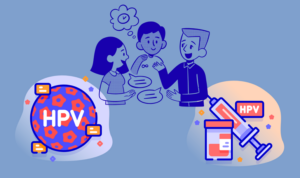Authors: Rhea Manohar, MPH; Meghan Etsey, Dr. Divya Krishnan on behalf of AMWA Gender Equity Task Force
Vaccine hesitancy remains a critical barrier to public health, playing a significant role in preventable disease outbreaks. For example, as of early July 2025, the US has recorded 1,288 measles cases, since eradication in 2000. While this number may not seem notable, it is the highest reported number of cases since 1992 according to the Centers for Disease Control and Prevention (CDC; Godoy 2025). This ongoing measles resurgence in the U.S. underscores the consequences of misinformation on public awareness and reluctance to vaccinate. For transmissible diseases, such as measles, protection and decreasing transmissibility depends on the public health concept of “herd immunity.” Herd immunity refers to the threshold of individuals who have received considerable protection against a virus or infectious agent causing low transmissibility for the group as a whole. In the case of vaccines, individuals who are vaccinated provide protection for themselves as well as their peers who may be unable to receive the vaccine due to underlying health concerns without either incurring serious risks or exposure (Cleveland Clinic 2025a). For the measles vaccine, this threshold is at 95% per the CDC, but due to an increase in vaccine misinformation and hesitancy, the current rate is at 92.7% (Godoy 2025).
Understanding the root of vaccine hesitancy is important for community leaders as well as medical and public health professionals to improve vaccine acceptance rates and community protection. According to the SAGE Working Group on Vaccine Hesitancy, individuals often cite lack of confidence in vaccines or the health care system, inaccessibility of vaccinations, and lack of perceived disease risk when choosing to decline vaccinations (MacDonald & SAGE Working Group on Vaccine Hesitancy, 2015). In understanding these facets of vaccine hesitancy, vaccine misinformation still plays a key role in knowledge and perception. For years the token example for vaccine misinformation was, and still is, Andrew Wakefield’s infamous Lancet journal case series incorrectly linking autism spectrum disorder to the measles, mumps, and rubella (MMR) vaccine (Lindsay 2020). While the misinformation from this study continues to persist in public discourse, there are many other reasons for vaccine hesitancy that are often not adequately addressed in physician-patient conversations. For public health and medical practitioners, a one-size-fits-all approach may not be as effective as communication techniques that focus on the myths and misconceptions regarding each individual vaccine. When trying to understand and combat vaccine hesitancy, misinformation is one part of a complex and multifaceted conversation.
The Human Papilloma Virus (HPV) vaccine, the most common of which is Gardasil-9, despite its well-documented safety and effectiveness, has been subject to a unique form of resistance—one heavily influenced by gendered misinformation (CDC 2024). This hesitancy not only endangers individual health but also reflects broader societal biases in how we approach preventive medicine. The HPV vaccine has been a groundbreaking advancement in cancer prevention. The two or three part vaccine series recommended in children and young adults has been shown to significantly reduce the incidence of cervical, oropharyngeal, and anal cancers, among others. Since their inception in 2006, the vaccination series has led to a 88% decrease in teenage females and 81% decrease in young adult women in HPV infections causing most HPV-related cancers and genital warts. Additionally, the cervical pre-cancers linked to the most common HPV-type related cervical cancers have decreased by 40% in vaccinated women (Centers for Disease Control and Prevention 2024). These statistics highlight the impact of the vaccine’s efficacy across the health spectrum. Despite its success, uptake remains lower than expected, due in part to persistent myths and misconceptions.
One of the most pervasive myths surrounding the HPV vaccine is that it is only necessary for young females because it prevents cervical cancer. While much of the public health campaigns surrounding HPV and vaccination have focused on its linkage to cervical cancer, HPV is responsible for a range of cancers that affect people of all genders, including vaginal, vulvar, penile, anal, and oropharyngeal cancers as well as genital warts (Cleveland Clinic 2025b). The lack of awareness and emphasis on the broader range of cancers linked to HPV and the misconception that “HPV only affects women” has led to lower vaccination rates among males, despite clear medical recommendations to vaccinate all children (Centers for Disease Control and Prevention 2024). One study examining the rural and urban differences in HPV vaccine uptake among rural and urban teens ages 13-17 years old using the National Immunization Survey-Teen (NIS-Teen) found a notable decrease in vaccination rates between rural and urban communities, with rural teens having lower odds than their urban counterparts. Even within these differences, rural young females from small rural towns (≥1 dose received 50.2%; ≥3 doses received 26.8%) were seen to have a much higher rate in vaccination than rural young males (≥1 dose 18.7%; ≥3 doses 5.50%; Swiecki-Sikora et al., 2019). This emphasizes the need for more targeted public health campaigns and medical education focusing on the importance of vaccination among both males and females.
Another common myth is the fear that vaccinating children against HPV will encourage early sexual activity. This claim remains pervasive in parenting groups and rhetoric regarding the HPV vaccine despite being debunked by multiple studies showing no correlation between vaccination and earlier or riskier sexual behavior (Brouwer et al., 2019). For those that are engaging in sexual activity, some studies noted that vaccinated individuals were more likely to practice safe sexual practices including using condoms and contraceptive methods (Taumberger et al., 2022). Yet, this belief persists, rooted in cultural anxieties around adolescent sexuality rather than scientific evidence.
Additionally, some parents question the need for vaccination if their child is not currently sexually active. Conversations extend from pediatric clinics to dining room tables discussing the need for a vaccination that is perceived to be primarily for a sexually-transmitted infection (STI). Although rhetoric and public knowledge surrounding HPV has primarily focused on sexual contact as the primary mode of transmission, research has shown that it is not strictly limited to sexual contact. A notable study examining HPV infections in celibate nuns found evidence of the virus, challenging the assumption that only sexually active individuals are at risk (Zimet at al., 2013). Other studies have found HPV infection through vertical transmission (via placenta) from mother to child, and the virus itself has been found to survive in water-based environments, suggesting potential transmission via skin-skin contact (Petca et al., 2020). This reinforces the need to reframe the HPV vaccine as a cancer prevention tool rather than solely an STI-related intervention. Furthermore, the HPV vaccination dosage series has been shown to be most effective when administered before potential exposure to HPV, with the CDC recommendation the first dosage be given at 11-12 years old (Centers for Disease Control and Prevention 2024). This highlights the critical need for early vaccination and messaging to build a foundation of trust between physicians, patients, and their families. With this in mind, providing individuals a safe space to ask about and address misconceptions, and promote vaccination prior to outbreaks such as what is currently occurring with measles.
The hesitancy surrounding the HPV vaccine reflects a larger trend of skepticism toward vaccines, contributing to the resurgence of preventable diseases like measles. The spread of misinformation, often amplified by social media, has fueled doubts about vaccine safety and necessity. By addressing the root causes of HPV vaccine hesitancy—misinformation, distrust in medical institutions, and cultural biases—we can better protect public health. To combat HPV vaccine hesitancy, we must shift the conversation away from gendered misconceptions and anxieties around early sexualization and toward its undeniable role in cancer prevention. Healthcare providers, educators, and policymakers must work together to ensure accurate information is widely accessible and that vaccination efforts reach all eligible individuals and their families. By addressing these challenges, we can move toward a future where preventable diseases, including HPV-related cancers, no longer pose a significant threat.
References
- Brouwer, A. F., Delinger, R. L., Eisenberg, M. C., Campredon, L. P., Walline, H. M., Carey, T. E., & Meza, R. (2019). HPV vaccination has not increased sexual activity or accelerated sexual debut in a college-aged cohort of men and women. BMC public health, 19(1), 821. https://doi.org/10.1186/s12889-019-7134-1
- Centers for Disease Control and Prevention. (2024, August 20). HPV vaccination. https://www.cdc.gov/hpv/vaccines/index.html
- Cleveland Clinic. (2025a, March 19). Herd immunity: History, vaccines, Threshold & What It Means. https://my.clevelandclinic.org/health/articles/22599-herd-immunity
- Cleveland Clinic. (2025b, June 30). What is the HPV vaccine? https://my.clevelandclinic.org/health/treatments/21613-hpv-vaccine
- Godoy, M. (2025, July 9). U.S. measles cases hit highest level in 33 years, CDC Reports. NPR. https://www.npr.org/sections/shots-health-news/2025/07/09/nx-s1-5461155/measles-outbreak-cdc-vaccination-health
- Lindsay P. (2020). Books: long read: The Doctor Who Fooled The World. Andrew Wakefield’s War On Vaccines: I Looked on Immunisation as an Example of Modern Living and Progress… and Then Came Andrew Wakefield. The British journal of general practice : the journal of the Royal College of General Practitioners, 71(702), 34–35. https://doi.org/10.3399/bjgp21X714557
- MacDonald, N. E., & SAGE Working Group on Vaccine Hesitancy. (2015). Vaccine hesitancy: Definition, scope and determinants. Vaccine, 33(34), 4161–4164. https://doi.org/10.1016/j.vaccine.2015.04.036
- Petca, A., Borislavschi, A., Zvanca, M. E., Petca, R. C., Sandru, F., & Dumitrascu, M. C. (2020). Non-sexual HPV transmission and role of vaccination for a better future (Review). Experimental and therapeutic medicine, 20(6), 186. https://doi.org/10.3892/etm.2020.9316
- Swiecki-Sikora, A. L., Henry, K. A., & Kepka, D. (2019). HPV Vaccination Coverage Among US Teens Across the Rural-Urban Continuum. The Journal of rural health : official journal of the American Rural Health Association and the National Rural Health Care Association, 35(4), 506–517. https://doi.org/10.1111/jrh.12353
- Taumberger, N., Joura, E. A., Arbyn, M., Kyrgiou, M., Sehouli, J., & Gultekin, M. (2022). Myths and fake messages about human papillomavirus (HPV) vaccination: answers from the ESGO Prevention Committee. International journal of gynecological cancer : official journal of the International Gynecological Cancer Society, 32(10), 1316–1320. https://doi.org/10.1136/ijgc-2022-003685
- Zimet, G. D., Rosberger, Z., Fisher, W. A., Perez, S., & Stupiansky, N. W. (2013, May 31). Beliefs, behaviors and HPV vaccine: Correcting the myths and the misinformation. Preventive Medicine. https://www.sciencedirect.com/science/article/pii/S009174351300176X
About the Authors
 Rhea Manohar is a third year medical student from St. George’s University. She has a Masters in Public Health with a concentration in Maternal and Child Health from George Washington University Milken Institute of Public Health and a Bachelors of Science in Microbiology, Immunology, and Public Health from the University of Miami. She served as Co-VP of OB/GYN Education for St. George’s University’s Women in Medicine chapter in St. George, Grenada where she developed and implemented hands-on workshops to further reproductive health issues and bolstered medical students abilities to navigate physician-patient communication. Prior to medical school, she was a Research Associate for Fors Marsh Group, where she led qualitative and quantitative public health research and campaign development for federal agencies (e.g., CDC, NIH, DHHS, CPSC). She is also a member of the Gender Equity Task Force and Reproductive Health Coalition within the American Medical Women’s Association. When she is not pursuing medicine, you can find her reading, exploring artistic passions, and spending time connecting with friends and family.
Rhea Manohar is a third year medical student from St. George’s University. She has a Masters in Public Health with a concentration in Maternal and Child Health from George Washington University Milken Institute of Public Health and a Bachelors of Science in Microbiology, Immunology, and Public Health from the University of Miami. She served as Co-VP of OB/GYN Education for St. George’s University’s Women in Medicine chapter in St. George, Grenada where she developed and implemented hands-on workshops to further reproductive health issues and bolstered medical students abilities to navigate physician-patient communication. Prior to medical school, she was a Research Associate for Fors Marsh Group, where she led qualitative and quantitative public health research and campaign development for federal agencies (e.g., CDC, NIH, DHHS, CPSC). She is also a member of the Gender Equity Task Force and Reproductive Health Coalition within the American Medical Women’s Association. When she is not pursuing medicine, you can find her reading, exploring artistic passions, and spending time connecting with friends and family.
 Meghan Etsey is a fourth year medical student from St. George’s University. She has a Bachelors of Arts in Biology and a Bachelors of Arts in Nutrition and Dietetics from Bluffton University in Bluffton, Ohio. She served as the President of the St. George’s University’s Women in Medicine chapter in St. George, Grenada where she expanded relationships with the community and worked towards educating women and helping the youth. She is also a member of the Gender Equity Task Force and Sex and Gender Health Collaborative Committees within the American Medical Women’s Association. When she is not pursuing medicine, you can find her with her friends and family on different road trips and adventures exploring the world.
Meghan Etsey is a fourth year medical student from St. George’s University. She has a Bachelors of Arts in Biology and a Bachelors of Arts in Nutrition and Dietetics from Bluffton University in Bluffton, Ohio. She served as the President of the St. George’s University’s Women in Medicine chapter in St. George, Grenada where she expanded relationships with the community and worked towards educating women and helping the youth. She is also a member of the Gender Equity Task Force and Sex and Gender Health Collaborative Committees within the American Medical Women’s Association. When she is not pursuing medicine, you can find her with her friends and family on different road trips and adventures exploring the world.
 Dr. Divya Krishnan obtained a medical degree with honours at the University of Medicine and Health Sciences, St. Kitts. She is passionate about preventative medicine and community medicine. She believes that we can only begin to move towards good health for all patients, with health equity and consistent community education led by healthcare workers. When not working in the medical world, she spends her spare time learning outdoors (hiking, rock climbing, gardening), learning indoors through reading books, and studying to brainstorm creative ideas for how to improve her practice as a whole- for her patients and for her co-workers.
Dr. Divya Krishnan obtained a medical degree with honours at the University of Medicine and Health Sciences, St. Kitts. She is passionate about preventative medicine and community medicine. She believes that we can only begin to move towards good health for all patients, with health equity and consistent community education led by healthcare workers. When not working in the medical world, she spends her spare time learning outdoors (hiking, rock climbing, gardening), learning indoors through reading books, and studying to brainstorm creative ideas for how to improve her practice as a whole- for her patients and for her co-workers.
